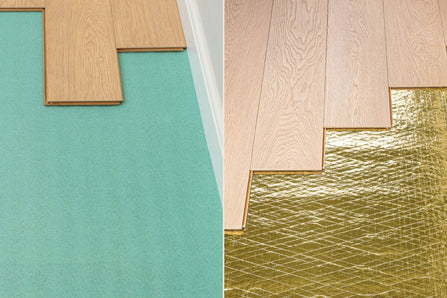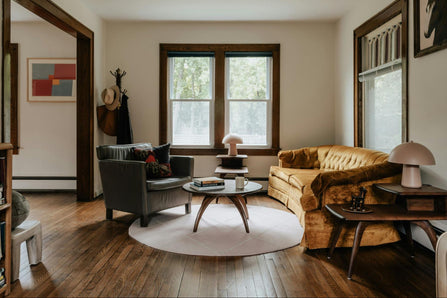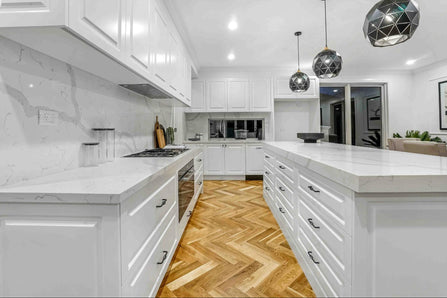How to Safely Take Up Laminate Flooring Without Damaging the Subfloor
Posted on by Online Carpets
Whether you’re renovating, replacing or treating your room to some brand new flooring, it’s usually possible to remove old or damaged laminate without damaging the subfloor underneath. This blog covers how to take up laminate flooring safely, as well as offering top tips for how to remove laminate flooring whilst keeping the original subfloor of your home intact.
Why You Might Need to Remove Laminate Flooring
Modern laminate flooring offers a durable, elegant, and versatile floor for any room in the home. However, ageing or poorly installed laminate may need replacing if it hasn’t been properly cared for, or if there’s been unexpected damage or flooding. You may also just fancy a change of colour or texture, or want to choose carpet for the space, instead.
Before installing your new flooring you’ll have to remove the laminate boards, taking care to keep the subfloor intact. Read on to find out how to take laminate flooring up yourself, the easy way.
Common Reasons to Take Up Laminate Flooring
If you’ve recently bought a property, you may wish to make your mark on it, and changing the flooring can add an instant lift to any space. With proper installation, care, and maintenance, laminate flooring can last up to 25 years.
Water damage or warping

Although our laminate flooring for bathroom areas is designed to be water-resistant and hard-wearing with an AC4 rating, older or poorly manufactured laminate may not fare as well under wet conditions. Excess water, steam, or unexpected flooding can lead to some laminates warping, moving, or pulling up. These will need replacing as soon as possible.
Style or design changes
Although wood-effect flooring never goes out of fashion, you may prefer a traditional look of stone, or tile-effect LVT in a bedroom or bathroom. Your laminate may also not be a colour of your choosing, too dark for the room, or be laid in a classic style like herringbone. There are a world of options when it comes to laminate and LVT, so removing old boards and replacing them with new ones can instantly update your interior design.
Subfloor inspection or repairs
Sometimes poor installation or usage can lead to subfloor damage, meaning you may need to remove any laminate which is laid on top. Leaking pipes, new kitchens, or electrical work may also require some or all of your laminate flooring to be taken up. If it’s just a small section and you wish to put it back as it was, pulling up your laminate carefully in order to preserve it is essential.
Can You Reuse Laminate Flooring?
It’s often possible to reuse good quality laminate flooring, if it's removed with care. If you’re replacing the flooring simply because it’s not to your taste, it may be possible to recycle the flooring for use elsewhere, or to sell on for others to use. By following our guide to how to pull up laminate flooring without damaging the boards or the floor underneath it can help to make reuse more likely, saving you money and reducing the impact on the environment by avoiding landfill and giving your old floor a new lease of life.
When reinstallation is possible
Laminate flooring with little to no damage, which has been well looked after can often be reused if it’s pulled up carefully. Tongue and groove, floating floors, or click-together laminate boards are usually the easiest to re-use as the boards aren’t glued down. If you’re handy at DIY you may well be able to reuse the flooring in another room, or even sell it on.
Signs your laminate isn’t reusable
Very worn laminate, warped, chipped, water-damaged, or stained boards won’t be able to be re-used and will need to be properly disposed of. If it’s only a few damaged sections though, the rest may be able to be reused for smaller spaces. Most glued-down floors are tricky to remove without damage, so these are unlikely to be able to be reused. As a composite, laminate is not usually able to be recycled so you’ll need to take it to a registered household waste recycling centre for disposal.
Required Tools and Preparation Before You Start
Before removing your old laminate floor, you’ll need a few essential tools as well as PPE to guard against any injuries. If you’re looking for the simplest and safest solution to how to take up laminate flooring yourself, making sure you’ve got all the tools you’ll need is key to avoiding damaging the flooring underneath, even if you’re not planning to re-use the boards.
Safety gear
Removing laminate can be dusty, messy, and hard on the hands, so you’ll need some safety protection, including:
- Work gloves – to guard against splinters and debris.
- Dust mask – to avoid dust inhalation.
- Safety goggles – to protect your eyes from debris.
- Protective footwear – to protect feet from splinters, uneven surfaces and tool dropping accidents.
Tools
You’ll need a few essential tools for removing the old flooring, including:
- A pry bar or crowbar – for lifting boards and/or separating planks.
- Floor scraper and chisel – to remove old boards and underlay.
- Hammer or mallet – to assist with removal.
- Pliers and screwdriver – for removing old nails and screws.
- Utility knife – cuts through old adhesive.
- A heat gun – if the boards are glued down, this helps to remove the old adhesive.
- Skip or sturdy waste disposal bag.
Prep the Area
Before you start, you’ll need to clear the room and create a clean space:
- Remove all furniture from the room.
- Check for glued vs. click-lock systems. This will affect how you’ll remove the boards, as well as how straightforward the job will be.
- Clean the floor to help reduce dust, and for non-glued boards to be reused.
- Before pulling the boards up you’ll need to remove the skirting boards first.
Step-by-Step Guide: How to Remove Laminate Flooring

If you’re handy at DIY, you may feel confident enough to remove the old laminate yourself, particularly if it’s a click-in system which hasn’t been glued down. This can help save you money. If you’re unsure though, ask a professional first. Always ensure the room is well ventilated before you start. Here’s how to take laminate flooring up without damaging the floor underneath.
Step 1: Start at a visible seam or edge
It’s easier to start at a visible seam or at an edge where the flooring naturally finishes. This will be your starting point, working across the floor gradually as you go. After identifying your starting point, inspect the edge for signs of whether the floor is glued down or simply clicked into place.
Step 2: Remove Skirting Boards/Beading and Thresholds
You’ll need to remove all skirting boards, beading, door bars, t-bars and edging before tackling the planks themselves. Use your tools to gently remove the skirting and thresholds, putting them aside for re-use.
Step 3: Lift the Laminate Flooring Panels
You can now start to gently lift the laminate boards, working on one at a time, across the room row by row. It’s recommended to lift each plank at a 45° angle to make removal easier. Use your pry bar or chisel to gently lift each board. You may need the hammer/mallet to assist with getting the pry bar under the plank.
Be sure to inspect the subfloor underneath for any damage, after removing the first plank, and adjust your technique if you’re using too much force. When you first inspect your subfloor, keep in mind that homes of a certain era (particularly if built between 1920 and 1980) could contain asbestos floor tiles. If you’re unsure, you may need professional testing and advice before you proceed with pulling up any more laminate.
For click-lock flooring, you’ll need to carefully disengage the joints as you move the boards away one by one. As you remove each panel, pull and wiggle the board at an angle to unhook it. It’s best to do this gently if you want the flooring to be reused, to avoid damaging the locking joints.
If the flooring is glued down, use the heat gun to soften the old adhesive before gently prising the panel up. Slide your floor scraper carefully under the board to avoid damaging the panels or leaving debris on the subfloor. You may need to go over the floor again with the heat gun and scraper to remove any residue, or use an adhesive remover.
What to Do if You’re Unable to Remove the Flooring
If you’re wondering how to pull up laminate flooring that is difficult to remove, or which seems fully stuck down, you may need to hire a motorised floor stripper, use a more powerful heat gun or adhesive remover, or consult a professional. It may also need some brute force, meaning the panels cannot be reused.
Step 4: Inspect and Protect the Subfloor
After you’ve removed all the boards, you may need to remove any additional laminate underlay that’s present. It’s now time to inspect your subfloor again. Depending on the age of the house, this may need some attention. If any adhesives have been used, you may need to continue scraping and/or using adhesive remover until the surface is smooth again. You can fill any holes made with screws or nails if you wish.
It’s essential to check for any moisture, water damage, or structural damage to the subfloor. If there’s significant damage to the subfloor, you can hire a professional to repair or replace this for you before your new flooring goes in. You’ll also need to address any damp or water damage before laying your new floor.
If the subfloor is in good condition, you can simply sweep or vacuum the flooring to remove dust and debris. The old floor should then safely be disposed of, or re-used.
How to Take Up Laminate Flooring Without Damaging the Subfloor
The best solution for how to take up laminate flooring without damaging the subfloor is to remove the old laminate slowly and carefully, avoiding prying the boards up using too much force. This can damage the floor underneath and increase the risk of injury. Using a specially designed floor scraper and heat gun to soften and remove any old adhesive is also highly effective. These can be hired or bought for the task.
Best Practices to Protect Your Subfloor
With some care and attention, you should be able to save your subfloor by:
- Using the correct tools for the job.
- Carrying out gentle lifting and separating techniques.
- Avoiding sharp tools that can gouge.
- Using any adhesive remover according to the manufacturer’s guide
- Working in sections to remove just one row at a time.
- Inspecting the subfloor after removal for any damage.
Mistakes to Avoid
If you’re not planning to reuse the floor it can be tempting to rip the old one up as quickly as possible. However, to protect your subfloor it’s best to avoid:
- Rushing the job.
- Using the wrong tools.
- Not using safety gear.
- Skipping inspection steps.
- Not repairing the subfloor before the new floor is laid.
Disposal and Recycling Options

Many click-lock laminate floors can be reused, and you may be able to sell the boards on to other renovators to raise some funds towards your new flooring. Be sure to take photos and accurate measurements before you pull the floor up if you’re looking to sell the boards on.
If the old flooring is damaged, defective, or glued down, it will need to be safely disposed of at a registered site, and cannot be put in household rubbish collections.
Can Laminate Flooring Be Recycled or Donated?
Some laminate may be able to be recycled, depending on the materials used and where you live. Contact your local authority for more information.
Although charities rarely accept old flooring for donations, it can be listed as ‘free to collector’ on selling sites, particularly if it’s good quality and removed with care. This form of recycling could help out another household who are looking for low cost or free flooring.
Thinking of Replacing Your Laminate?
If your laminate looks a bit tired, dated, or has been damaged over the years, why not replace it with a stylish, modern alternative? From wood-effect in a wide variety of shades, to stone-effect or classic herringbone designs, laminate flooring is durable, ultra-practical and looks great in bedrooms, hallways, living rooms, bathrooms or kitchens.
Why Choose Laminate Flooring from Online Carpets
At Online Carpets, we stock a huge choice of laminate flooring for any room in your home. It’s quick to install, designed to last, and is low-maintenance for busy households and families. Browse our luxury laminate or budget-friendly ranges, as well as pet-proof and scratch-resistant laminates and realistic wood finishes in contemporary colours and designs. Plus, with our price guarantee you know you’ll be getting the best products at the lowest prices.
Browse Our Laminate Flooring Collection
Browse our laminate flooring collection today to get inspired and give your home a lift – for less. Whether you want a complete interior revamp or a new shade to brighten up a dull space, we’ve got the right flooring to fit your space and your budget.
Choose the Right Floor With Our Samples
Explore sleek colours, exciting designs, and order your free samples today to try before you buy. If you’re struggling to choose the best options, or you’d like some helpful advice, contact our friendly customer services team who will be happy to help.
All ready to order? Check out our fitting advice and guides for professional tips on installing and maintaining your new flooring.
Installing New Flooring?
If you’re planning to install your own flooring, take a look at our advice centre for help with measuring and ordering your ideal flooring. Loving the look of laminate? Here’s how to lay laminate flooring yourself, as well as our handy guide to underlay and different laminate types.
Ready for your interior upgrade? Discover high-quality, affordable and long-lasting laminate flooring at Online Carpets. We’re your one-stop shop when it comes to stylish and sophisticated flooring without the price tag to match.



